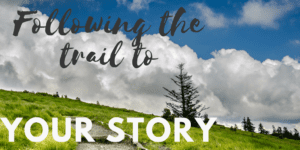We have so many things we want to share in our story. But, where to start? How will you know what is the real story? How do you find the story that makes a difference to you and the reader?
Understand that a story is an invitation to enter into a dynamic relationship between:
- The Story.
- The Storyteller.
- The Audience/reader.
As these elements connect waves of communication and energy flow between each element evolving the message and the content of your story.
For instance, you want to write or tell your story about a disability. However, your story isn’t really about the disability, it is your experience with the disability that provides the reader/audience an entry into the world familiar to you and uncommon to others.
Each family’s experience is different, even if your children share the same type of disAbility, because your world and your point of view are unique. As you tell your story we want to know your roots, your perspective, and how you approach the challenges and successes you encounter because of your child’s experience with a disAbility.
As we get to know you, we learn more about your background and character. What region of the country were you born into? How did your ancestors influence the person you became? What are some of your passions?
In reflection on my own background, I didn’t have to look too far to find a pioneering spirit coursing through my veins like a fish swims in the sea.
I come from western pioneers. Those summer blonde Swedes with sky blue eyes on my father’s side were prairie pioneers tilling the fertile lands of Nebraska. Their early homes were made of sweat and sod and somehow they managed to stay fresh, elegant, and strong. My paternal grandfather’s family were Scots, excellent at business, who settled in Montana establishing themselves in the burgeoning lumber business. On my mother’s side, pale skin and dark haired Irish settlers worked in the coal mines of the Rocky Mountains. They hauled silver ore over Independence Pass in Colorado, later homesteading in the rich and fertile Yampa Valley of Steamboat.
My ancestors pioneered this landscape in the 1880’s and I traversed the frontier landscape of inclusion in the 1980’s feeling their spirit pulse with every beat of my heart. My brethren were smart, resourceful and fiercely loyal.
Now, take a few minutes and reflect upon your own background. A good starter sentence begins with…The people I came from were…… and let the pen do the rest. If you get stuck, just write the starter sentence over and over again until your heart spills out its treasures.
Storytelling is about choice, description, and relatability. Story follows heart and structure.
There are six basic stages to the Dramatic Arc of storytelling. Basically, there is an event that changes normal life known as the inciting incident. This moment can be the birth of your child, an initial diagnosis, which creates tension and rising action presenting the protagonist (you) with difficult choices and dilemmas. The challenge begs for a resolution while at the same time the resolution seems impossible. Events and encounters result in some kind of decision and resolution realizing your victory, or a better understanding and participation by new support or a return to the current situation.
Here are the six stages of storytelling.
- Exposition/Introduction: Describe your normal, ordinary world.
- Inciting Incident: Something happens. This drives your story.
- The Pinch: Rising Action. The intensity of events increase and the conflict grows.
- Climax: Turning point when events and situations change, for better or worse.
- Pinch #2: One more difficulty resulting in Falling Action: Suspense is prolonged as difficulties are confronted and questions are recognized and sometimes answered.
- Resolution/Denouncement: Remain issues are reconciled. A sense of normalcy is reinstated. Characters, choices, and actions are validated and future possibilities are presented. What changed the course of the story?
In telling your story include rich details to give us a feel for your family.
Here are some examples:
- My daughter’s hands are delicate. Her long fingers struggle to grasp her spoon as her muscles wrestle with her bones and nerves to reach her goal. A bite of food waits patiently.
- Every time my son’s eyes shine with glee, I am tickled beyond words. His laughter is free, full of joy, until his lungs fill with fluid he cannot release. His cells fill up locking out his breath as he coughs and squirms and panic quickly replaces joys. My hand cups, preparing to hit his back, shaking loose the phlegm restricting his delight.
- I hear my grandchild’s silence and smile. His world is quiet now. The fury of sound bombarding him disappears as he sits in the garden reaching for his smartphone. The earphones lodged securely in his perfect ears, his index finger scrolls through the digital pages finally landing on his favorite app; iMovie. He is in his zone, making movies.
Now, pick a feature or quality you love about your family member. Describe the joys and challenges they face every day. Think about the “one” thing that could make an immediate difference in their lives. Is it a device, a job, some funding? How would that “one” thing make a difference? Now, describe its life changing properties.
My hope is you have found your storyline. For more thoughts on storytelling take a look at my second session with Viki King, author of How to Write a Movie in 21 Days.
Check in next month for our storytelling template! Your stories are amazing!

